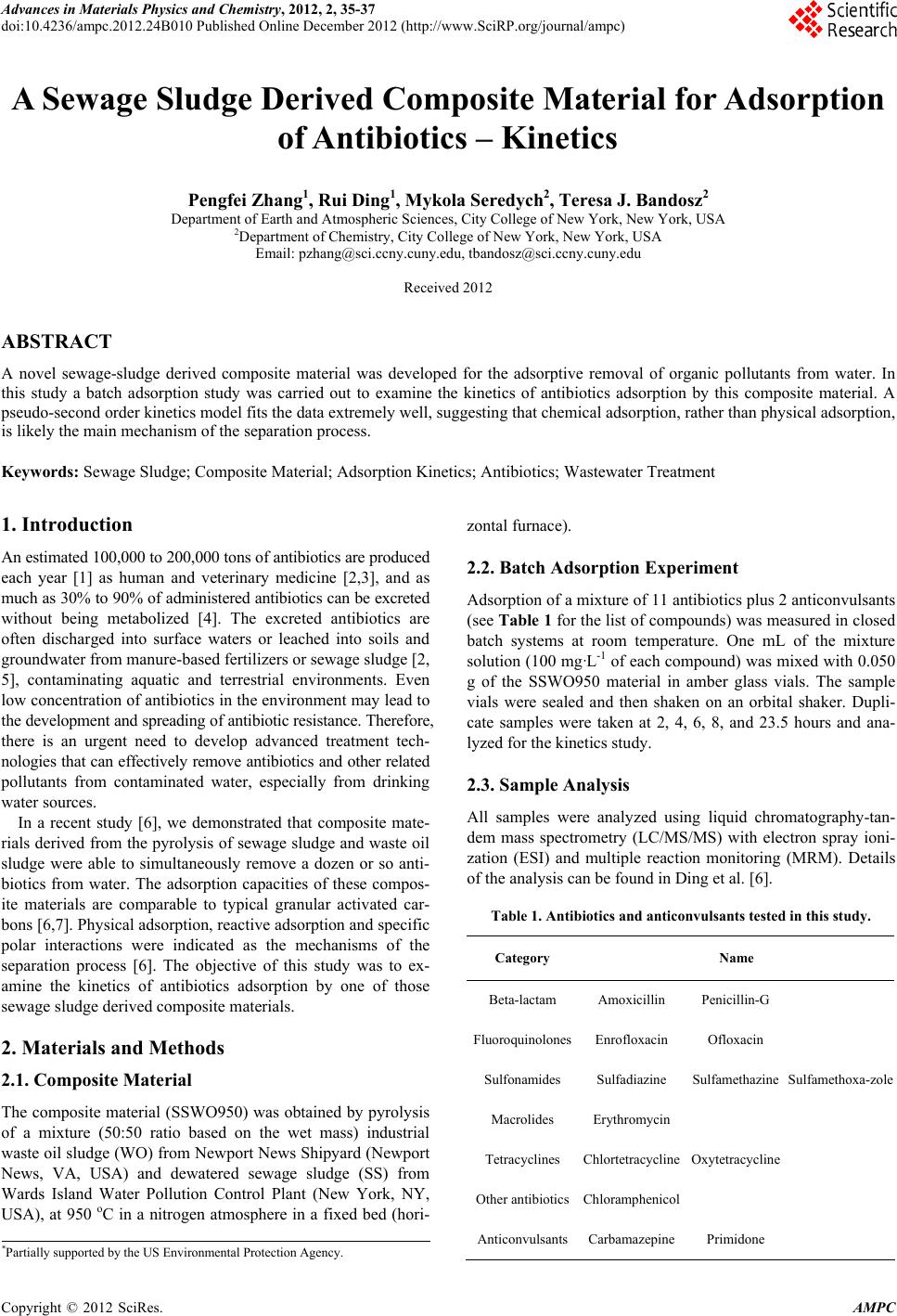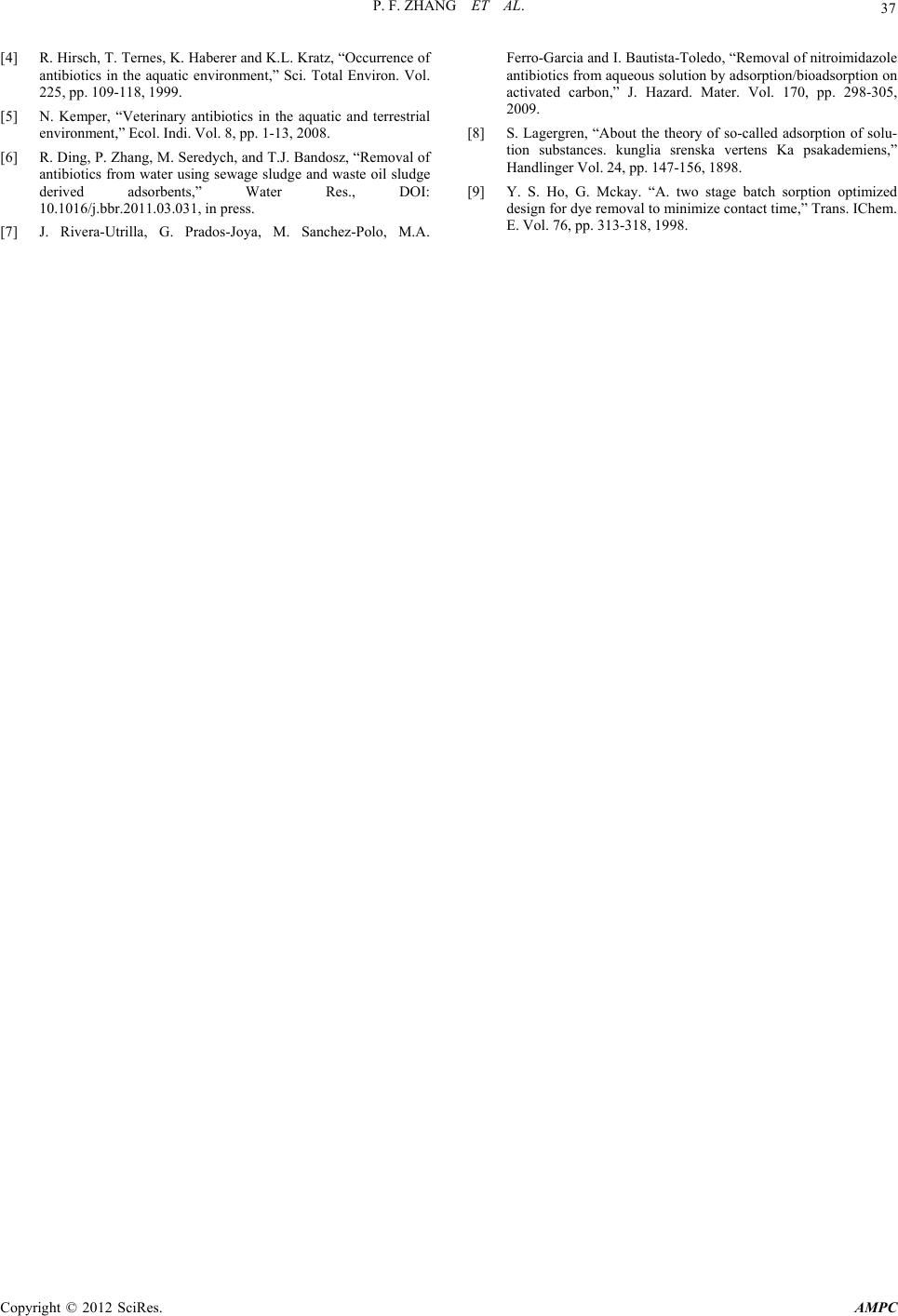Paper Menu >>
Journal Menu >>
 Advances in Materials Physics and Chemistry, 2012, 2, 35-37 doi:10.4236/ampc.2012.24B010 Published Online December 2012 (http://www.SciRP.org/journal/ampc) A Sewage Sludge Derived Composite Material for Adsorption of Antibiotics – Kinetics Pengfei Zhang1, Rui Ding1, Mykola Seredych2, Teresa J. Bandosz2 Department of Earth and Atmospheric Sciences, City College of New York, New York, USA 2Department of Chemistry, City College of New York, New York, USA Email: pzhang@sci.ccny.cuny.edu, tbandosz@sci.ccny.cuny.edu Received 2012 ABSTRACT A novel sewage-sludge derived composite material was developed for the adsorptive removal of organic pollutants from water. In this study a batch adsorption study was carried out to examine the kinetics of antibiotics adsorption by this composite material. A pseudo-second order kinetics model fits the data extremely well, suggesting that chemical adsorption, rather than physical adsorption, is likely the main mechanism of the separation process. Keywords: Sewage Sludge; Composite Material; Adsorption Kinetics; Antibiotics; Wastewater Treatment 1. Introduction An estimated 100,000 to 200,000 tons of antibi oti cs are produced each year [1] as human and veterinary medicine [2,3], and as much as 30% to 90% of administered antibiotic s can be excreted without being metabolized [4]. The excreted antibiotics are often discharged into surface waters or leached into soils and groundwater from manure-based fertilizers or sewage sludge [2, 5], contaminating aquatic and terrestrial environments. Even low concentration of antibiotics in the environment may lead to the development and spreading of antibiotic resistance. Therefore, there is an urgent need to develop advanced treatment tech- nologies that can effectively remove antibiotics and other related pollutants from contaminated water, especially from drinking water sources. In a recent study [6], we demonstrated that composite mate- rials derived from the pyrolysis of sewage sludge and waste oil sludge were able to simultaneously remove a dozen or so anti- biotics from water. The adsorption capacities of these compos- ite materials are comparable to typical granular activated car- bons [6,7]. Physical adsorption, reactive adsorption and specific polar interactions were indicated as the mechanisms of the separation process [6]. The objective of this study was to ex- amine the kinetics of antibiotics adsorption by one of those sewage sludge derived composite materials. 2. Materials and Methods 2.1. Composite Material The composite material (SSWO950) was obtained by pyrolysis of a mixture (50:50 ratio based on the wet mass) industrial waste oil sludge (WO) from Newport News Shipyard (Newport News, VA, USA) and dewatered sewage sludge (SS) from Wards Island Water Pollution Control Plant (New York, NY, USA), at 950 oC in a nitrogen atmosphere in a fixed bed (hori- zontal furnace). 2.2. Batch Adsorption Experiment Adsorption of a mixture of 11 antibiotics plus 2 anticonvulsants (see Table 1 for the list of compounds) was measured in closed batch systems at room temperature. One mL of the mixture solution (100 mg·L-1 of each compound) was mixed with 0.050 g of the SSWO950 material in amber glass vials. The sample vials were sealed and then shaken on an orbital shaker. Dupli- cate samples were taken at 2, 4, 6, 8, and 23.5 hours and ana- lyzed for the kinetics study. 2.3. Sample Analysis All samples were analyzed using liquid chromatography-tan- dem mass spectrometry (LC/MS/MS) with electron spray ioni- zation (ESI) and multiple reaction monitoring (MRM). Details of the analysis can be found in Ding et al. [6]. Table 1. Antibiotics and anticonvulsants tested in this study. Category Name Beta-lactam Amoxicillin Penicillin-G FluoroquinolonesEnrofloxacin Ofloxacin Sulfonamides Sulfadiazine Sulfamethazine Sulfamethoxa-zole Macrolides Erythromycin Tetracyclines Chlortetracycline Oxytetracycline Other antibioticsChloramphenicol AnticonvulsantsCarbamazepinePrimidone *Partially supported by the US Environmental Protection Agency. Copyright © 2012 SciRes. AMPC  P. F. ZHANG ET AL. 36 2.4. Kinetic Mode ling Both the pseudo-first order and pseudo-second order kinetics models were used to fit the experimental data. The equation for the pseudo-first order model is as follows [8]: 1 dd te qtkqq t (1) where qe and qt are the sorption capacities (mg·g-1) at equilib- rium and at time t, respectively, and k1 is the rate constant of the pseudo-first order sorption (L·hr-1). Integrating (1) from t = 0 to t and qt = 0 to qt yields: 1 log log et e qq qkt (2) If pseudo-first order kinetics is applicable, then a plot of log(qe-qt) vs. t should yield a straight line and the slope corre- sponds to k1. Here the sorption capacities determined at 48 hours were used as qe. The equation for the pseudo-second order model is written as follows [9]: 2 2 dd te qtkqq t (3) where k2 is the rate constant of the pseudo-second order sorp- tion (g·mg-1·hr-1). Integrating (3) from t = 0 to t and qt = 0 to qt yields: 2 11 et e qq qkt (4) Rearranging (4) gives the linearized form: 2 2 1 te tqkq tq e (5) If pseudo-second order kinetics is applicable, a plot of t/qt vs. t should give a straight line, from which qe and k2 and can be determined from the slope and intercept of the line. 3. Results and Discussion The pseudo-first order kinetics model did not fit the data well (plots not shown), whereas the pseudo-second order kinetics model yielded excellent fits for all compounds (Figure 1, r2 > 0.996), suggesting a chemical adsorption process rather than a physical adsorption process. The fitted qe and k2 values are listed in Table 2. Chlortetra- cycline, carbamazepine, oxytetracycline, and enrofloxacin ap- pear to have the highest pseudo-second order rate constants Figure 1. A plot of t/qt vs. t according to (5). Straight lines repre- sent the best fits. All r2 values of the fits are greater than 0.996. Table 2. Fitted parameter values from the Pseudo-second order kinetics mod e l. Pharmaceuticals qe (mg·g-1) k2 (g·mg-1·hr-1) Amoxicillin (AMO) 2.04 7.19 Carbamazepine (CAB) 0.67 52.05 Chloramphenicol (CHP) 1.95 7.36 Chlortetracycline (CTC) 1.69 94.98 Enrofloxa cin (ENR) 0.94 45.09 Erythromycin (ERY) 2.01 31.68 Ofloxacin (OFL) 1.51 17.33 Oxytetracycline (OTC) 1.89 45.68 Penicillin-G (PEN-G) 1.81 2.68 Primidone (PRM) 1.59 2.57 Sulfadiazine (SDZ) 0.61 5.15 Sulfamet hazine (SMZ) 2.07 4.96 Sulfamethoxazole (SMX) 1.96 0.95 SUM 20.75 (>45 g·mg-1·hr-1), whereas penicillin-G, primidone, and sul- famethoxazole seem to have the lowest rate constants (<3 g·mg-1·hr-1, Table 2). Based on the kinetics experiments performed here, most of the compounds have equilibrium sorption capacities around 2 mg·g -1, whereas carbamazepine and sulfadiazine have lower capacities (around 0.6 mg·g-1). The total sorption capaci ty (sum of all compounds) is around 21 mg·g-1. The total capacity de- termined here, however, is an order of magnitude lower than that determined by equilibrium adsorption experiments with higher contaminant loadings [6]. 4. Acknowledgements This work was partially supported by a STAR grant from the United States Environmental Protection Agency (US EPA, RD835178). Any opinions, findings, and conclusions or rec- ommendations expressed in this material are those of the au- thors and do not necessarily reflect the views of the US EPA. R. Ding would like to acknowledge a graduate fellowship from the Office of the Dean of Science. REFERENCES [1] R. Wise, “Antimicrobial resistance: priorities for action,” J. Antimicrob. Chemoth. Vol. 49, pp. 585-586, 2002. [2] A.B.A. Boxall, D.W. Kolpin, B. Halling-Sorensen, and J.Tolls, “Are veterinary medicines causing environmental risks?” Envi- ron. Sci. Technol. Vol. 37, pp. 286A-294A, 2003. [3] A.K. Sarmah, M.T. Meyer, and A.B.A. Boxall, “A global per- pective on the use, sales, exposure pathways, occurrence, fate and effects of veterinary antibiotics (VAs) in the environment,” Chemosphere Vol. 65, pp. 725-729, 2006. Copyright © 2012 SciRes. AMPC  P. F. ZHANG ET AL. Copyright © 2012 SciRes. AMPC 37 [4] R. Hirsch, T. Ternes, K. Haberer and K.L. Kratz, “Occ urrence of antibiotics in the aquatic environment,” Sci. Total Environ. Vol. 225, pp. 109-118, 1999. [5] N. Kemper, “Veterinary antibiotics in the aquatic and terrestrial environment,” Ecol. Indi. Vol. 8, pp. 1-13, 2008. [6] R. Ding, P. Zhang, M. Seredych, and T.J. Bandosz, “Removal of antibiotics from water using sewage sludge and waste oil sludge derived adsorbents,” Water Res., DOI: 10.1016/j.bbr.2011.03.031, in press. [7] J. Rivera-Utrilla, G. Prados-Joya, M. Sanchez-Polo, M.A. Ferro-Garcia and I. Bautista-Toledo, “Removal of nitroimidazole antibiotics from aqueous solution by adsorption/bioadsorption on activated carbon,” J. Hazard. Mater. Vol. 170, pp. 298-305, 2009. [8] S. Lagergren, “About the theory of so-called adsorption of solu- tion substances. kunglia srenska vertens Ka psakademiens,” Handlinger Vol. 24, pp. 147-156, 1898. [9] Y. S. Ho, G. Mckay. “A. two stage batch sorption optimized design for dye removal to minimize contact time,” Trans. IChem. E. Vol. 76, pp. 313-318, 1998. |

